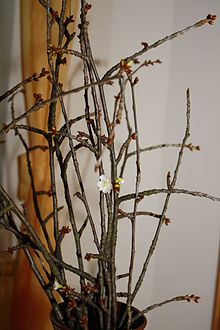Barbara branch
Barbara branches are branches of fruit trees, which according to an old custom on December 4th , the liturgical remembrance day of St. Barbara in the Roman Catholic and Greek Orthodox Churches (Barbaratag) , cut and placed in a vase in the apartment. Depending on the area and customs, cherry, apple, birch , hazelnut , horse chestnut , plum, elder , hawthorn or forsythia branches are used for forcing . They should bloom by Christmas Eve and decorate the apartment for Christmas .
regional customs
The custom goes back to a tradition of the saint , according to which she got caught with her robe on a branch on the way to the prison. She put the broken branch in a jar of water and it bloomed on the very day she was martyred .
According to regional folk belief , the blossoming of the Barbara branches will bring good luck in the coming year. Sometimes it is customary for the young girls to assign the name of a suitor to each branch. The branch that blooms first is intended to indicate the future bridegroom. But Barbara branches were also the basis of other oracles, such as harvest oracles, where the number of flowers showed the size of the harvest, or they were also used to predict lottery numbers. This custom has its analogies in many cultures (“ rod of life ”) and is therefore one of the many oracle customs. The barbara tree has been documented in writing since the 13th century .
A peasant rule says: "Buds on St. Barbara, there are flowers for Christmas."
Barbara tree
A special form of the barbara branch is the custom of setting up a barbara tree , also known locally as Christmas May. Whole branches or coarser twigs of fruit trees, sometimes also chestnut, birch and rowan berries, are used in a Barbara tree, which were richly hung with gilded nuts and apples, later also with glass Christmas tree decorations. The name Barbara tree is derived from the custom to cut these branches a few days before the commemoration of St. Barbara - some sources mention St. Andrea's day - to cut and put in the warm room on St. Barbara's day , so that the branches blossomed at Christmas. Such a barbara tree could take up the entire wall of a room or an entire corner of the room. In the 18th century the Bayreuth margrave had the erection of barbara trees forbidden because of the rampant looting of fruit trees.
literature
- Manfred Becker-Huberti : Lexicon of customs and festivals 3000 keywords with information, tips and backgrounds. Herder, Freiburg im Breisgau 2000, ISBN 3-451-27317-9 .
- Marie-Louise Nussbaumer-Keller: The Barbarazweig: Stories for Advent and Christmas , Rebstein 2004, ISBN 3-03-300188-2 .
- Richilde Paul, Werner Paul: The Bavarian Holy Heaven. Religious custom throughout the year. Plenk Verlag , Berchtesgaden 2003, ISBN 3-927957-29-1 .
- Ingeborg Weber-Kellermann: The Christmas festival, a cultural and social history of the Christmas season , Verlag Bucher CJ, Lucerne, Frankfurt am Main 1978, ISBN 3-7658-0273-5 .
Web links
- The custom of the Barbara branches
- Entry for December 4th - Barbara: On the green branch in the Austria-Forum
Individual evidence
- ↑ Entry on Barbarazweig in the Austria Forum (in the ABC on Austrian Folklore), accessed on December 5, 2011
